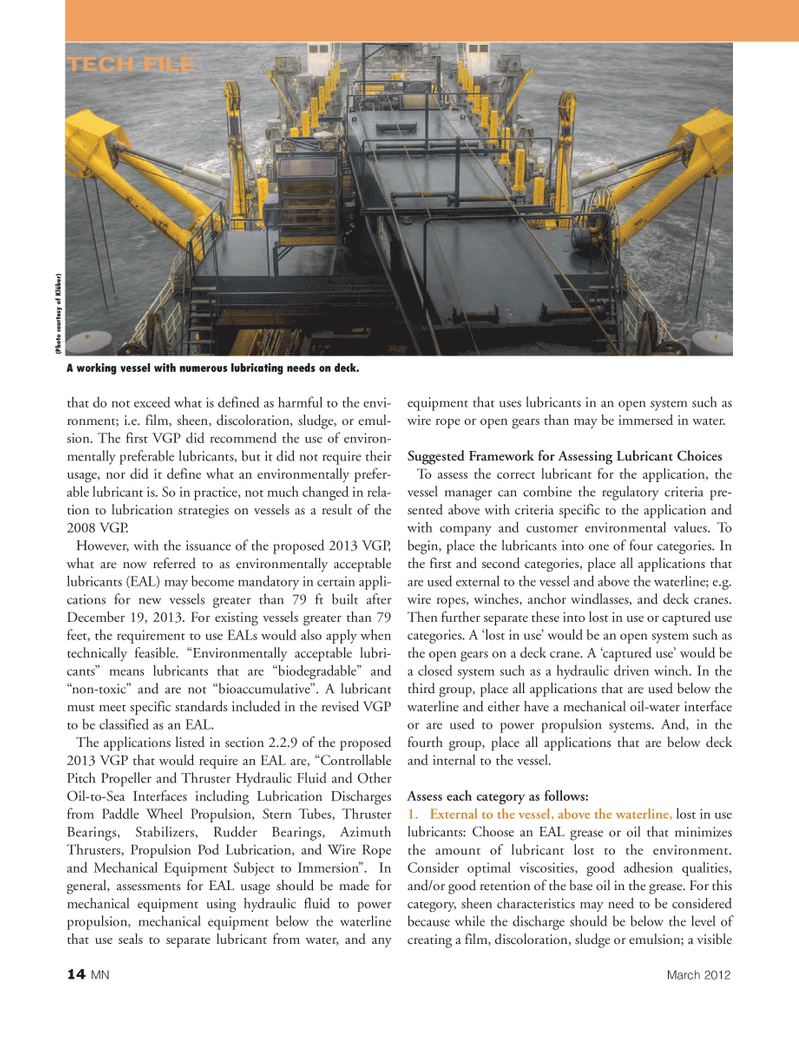
Page 14: of Marine News Magazine (March 2012)
Training & Education
Read this page in Pdf, Flash or Html5 edition of March 2012 Marine News Magazine
14MNMarch 2012 TECH FILEthat do not exceed what is defined as harmful to the envi- ronment; i.e. film, sheen, discoloration, sludge, or emul- sion. The first VGP did recommend the use of environ- mentally preferable lubricants, but it did not require their usage, nor did it define what an environmentally prefer- able lubricant is. So in practice, not much changed in rela- tion to lubrication strategies on vessels as a result of the 2008 VGP. However, with the issuance of the proposed 2013 VGP, what are now referred to as environmentally acceptable lubricants (EAL) may become mandatory in certain appli- cations for new vessels greater than 79 ft built after December 19, 2013. For existing vessels greater than 79 feet, the requirement to use EALs would also apply when technically feasible. ?Environmentally acceptable lubri- cants? means lubricants that are ?biodegradable? and ?non-toxic? and are not ?bioaccumulative?. A lubricant must meet specific standards included in the revised VGP to be classified as an EAL. The applications listed in section 2.2.9 of the proposed 2013 VGP that would require an EAL are, ?Controllable Pitch Propeller and Thruster Hydraulic Fluid and Other Oil-to-Sea Interfaces including Lubrication Discharges from Paddle Wheel Propulsion, Stern Tubes, Thruster Bearings, Stabilizers, Rudder Bearings, Azimuth Thrusters, Propulsion Pod Lubrication, and Wire Rope and Mechanical Equipment Subject to Immersion?. In general, assessments for EAL usage should be made formechanical equipment using hydraulic fluid to power propulsion, mechanical equipment below the waterline that use seals to separate lubricant from water, and any equipment that uses lubricants in an open system such aswire rope or open gears than may be immersed in water. Suggested Framework for Assessing Lubricant Choices To assess the correct lubricant for the application, the vessel manager can combine the regulatory criteria pre- sented above with criteria specific to the application and with company and customer environmental values. To begin, place the lubricants into one of four categories. In the first and second categories, place all applications thatare used external to the vessel and above the waterline; e.g. wire ropes, winches, anchor windlasses, and deck cranes. Then further separate these into lost in use or captured use categories. A ?lost in use? would be an open system such as the open gears on a deck crane. A ?captured use? would be a closed system such as a hydraulic driven winch. In the third group, place all applications that are used below the waterline and either have a mechanical oil-water interface or are used to power propulsion systems. And, in the fourth group, place all applications that are below deck and internal to the vessel. Assess each category as follows: 1.External to the vessel, above the waterline, lost in uselubricants: Choose an EAL grease or oil that minimizes the amount of lubricant lost to the environment. Consider optimal viscosities, good adhesion qualities,and/or good retention of the base oil in the grease. For this category, sheen characteristics may need to be considered because while the discharge should be below the level of creating a film, discoloration, sludge or emulsion; a visible (Photo courtesy of Klüber)A working vessel with numerous lubricating needs on deck. MN#3 (1-17):MN 2011 Layouts 3/2/2012 10:53 AM Page 14

 13
13

 15
15
